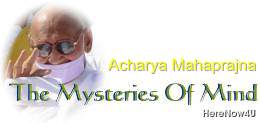
Thesis and antithesis, the positive and the negative, are essential characteristics not only of the material world but also of the spiritual world. Mahavira's doctrine of anekanta vada is not a mere intellectual proposition. It is a doctrine of practical synthesis. In the course of his self-exertion, when he was trying to attain a state of ahimsa, he came to feel a sense of friendliness towards all and realized that he had no enemies. The feeling of enmity is the result of false consciousness, which makes the mind inhibited with a single idea or point of view. He, therefore, propounded the doctrine of the many-pointedness of truth and insisted on the need for synthesis in our relations with others.
The second stage of the search for truth is the utilization of breath and the mind in self-exertion. People often ask how to put a check on and control the mind, which is absolutely fickle. The truth is that the mind is not lonely and does not work independently. It is being constantly fanned by other forces. If there is a strong wind, a flag mounted on a building will begin to flutter. You cannot stop the fluttering of the flag so long as the wind blows. If it snows, the air will become cold. You cannot make the air cool so long as the temperature is high.
There are two things to be considered in connection with the mind:
- The working mind and
- The empty mind.
There are two states of the working mind:
- Mind employed or engaged in the activity we are doing.
- The wayward mind which remains busy elsewhere rather than in the activity we are doing.
In both these states the mind remains active. These two states come under the category of the working mind. There is another category in which the mind does not at all work. It remains empty. Like the empty mind the body can also be carried into a state in which it becomes immobilized. Both the mind and the body can be abandoned. In the state of abandonment they will not work and will become as good as dead.
A female practitioner told me that while she was engaged in breath perception, she felt only the vibrations and rhythm of breathing and the feeling of having a body completely disappeared. Sadhana does produce such a kind of lightness in which we do not feel that we have a body.
There is an anecdote about a Zen meditator. He was meditating. When his meditation reached a state of consummation, he felt himself absolutely light. Suddenly he got up and shouted, "Where is my body? Will someone please search it out?" It so happens in meditation that the meditator becomes so light that he ceases to feel his body. Instead of feeling the body he begins to sense that a swarm of atoms is whirling all around him.
This is a state in which the mind ceases to function and becomes defunct and this results in the abandonment of the body also. The body also disappears from the meditator's consciousness along with his mind.
Let us understand the states of mindfulness and mindlessness together. While the mind is working, the practitioner should think of abandoning it. But it is necessary to gear it to a different base so that instead of wandering from one object to another, it becomes fixed on a single object or point, or in other words it becomes one-pointed mind. The object on which the mind is to be fixed for a long time should, however, be a pure object and it should be made to flow in the direction of this object only. All the currents of the mind should be collected together into a single current.
Breath-perception is a device to concentrate the mind on the process of breathing. The flow of breath and that of the mind should go hand in hand with each other. And we should try to retain this state for as longer a time as possible. Let us watch the process of breathing and let the mind also watch it. Let the mind run on the heels of breath.
It is breath, which supports life, and breathing is an essential activity of life. Unfortunately we have mostly neglected it. We do not know long-breathing. It takes time to practise it. Let us not forget that breathing is a natural activity of the body and a very easy activity. In the practice of long-breathing we have nothing to receive from outside the body. Breath is there in us and we have simply to catch it and practise breathing.
We should practise breath-perception, body-perception and practise normal breathing by watching it as much as we can. Whenever we get a little time, let us employ it in perceiving breathing. Let us carry the mind up and down and watch each and every particle of the body. In doing so we do not need the assistance of any thing outside the body. We need not choose any particular time or place for it. We can do it any time, even while walking or sitting or moving in a vehicle. There will then be no complaint that the mind is wandering about and that it is difficult to control it. This is the first stage.
The second stage consists of emptying the mind. This will lead you to a state of happiness and joy. A concentrated mind ceases to be fickle.
In the course of lesya meditation the meditator comes to see a glow of light. He perceives something dazzling. The world within him begins to vibrate, shining colours begin to appear before his eyes and he enters into a state in which the mind ceases to function and becomes as good as dead. So far as the mind functions, we remain conscious of time. The sense of time disappears as soon as the mind has been emptied. An hour appears as short as a minute. A. state of mindlessness is free from the sense of time. In this state we do not remain confined within space. We become free from the limitations of space and time. A state of mindlessness is a state of thoughtlessness. But it is not easy to attain this state. It is attained by self-exertion. It needs a lot of patience and practice.
The modern man is impatient. He wants to reap the crop before it is ripe. He wants immediate results and returns. This attitude is a great obstacle in sadhana. A genuine sadhaka eschews hurry. A certain gentleman who had put on shoes too tight to wear easily was walking on a road. A passer-by saw him walking uneasily and asked what was the wrong with him. The gentleman replied. "How does it concern you?" Pointing out at the tight shoes the passer-by again asked, "From where did you procure these shoes?" The gentleman, seemingly annoyed, replied. "I plucked them from a tree. "Jokingly the passer-by remarked. "You could have very well waited till the shoes became ripe." Unripe sadhana is fraught with difficulties. Success in sadhana takes a long-time to achieve. The state of mindlessness cannot be achieved in a hurry. A steady mind, a pure ideal and a one-pointedness of the currents of the mind will certainly bear fruit. Above all, the practitioner will have to rely on his own experience.
Said Mahavira "Search Truth yourself."
 Acharya Mahaprajna
Acharya Mahaprajna

